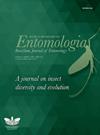了解柏油蝇系统发育关系的又一步:对Bruggmanniella s.l.(双翅目,瘿蚊科)的两个假设的重新审视
IF 1.3
4区 农林科学
Q4 ENTOMOLOGY
引用次数: 2
摘要
本文提出了一种基于形态学数据的系统发育分析的布鲁格曼尼尔氏菌属划分的更新。在这项工作中,我们加强了之前对密切相关的Bruggmanniella、Pseudasphondylia、Illiciomyia和Odontokeros属的系统发育分析结果,在Lin等人(2020)有争议的分子方法之后,本文将其命名为Bruggmanniella s.l。我们还纳入了Bruggmanniella在2019 - 2020年间描述的物种,并讨论了与Bruggmanniella物种生态位占据相关的蛹形态进化变化的一些方面。结果证实了我们先前对Bruggmanniella s.l的划分,分为三个分支:一个分支完全由Bruggmanniella的新热带物种组成;另一个支科,含有只在日本发现的假水仙属;最后一个分支为台湾优势分布的齿齿龙种。我们的结果也支持了Odontokeros属和Illiciomyia属的重新验证本文章由计算机程序翻译,如有差异,请以英文原文为准。
Another step towards understanding phylogenetic relationships in Asphondyliini: revisiting two hypotheses to Bruggmanniella s.l. (Diptera, Cecidomyiidae)
A C T An update of the delimitation of the genus Bruggmanniella based on phylogenetic analysis using morphological data is presented. In this work, we reinforced the results of the previous phylogenetic analysis of the closely related genera Bruggmanniella, Pseudasphondylia, Illiciomyia and Odontokeros, assigned here as Bruggmanniella s.l after the controversial molecular approach of Lin et al. (2020). We also included the species described under Bruggmanniella between 2019 and 2020 and discuss some aspects of the evolutionary changes of pupal morphology related with niche occupation of Bruggmanniella species. The results confirm our previous delimitation of the Bruggmanniella s.l arranged into three branches: one branch composed exclusively with the Neotropical species of Bruggmanniella; another branch containing the species of Pseudasphondylia, found only in Japan; and the last branch with species of Odontokeros with predominant distribution in Taiwan. Our results also support the revalidation of the genus Odontokeros, and Illiciomyia as
求助全文
通过发布文献求助,成功后即可免费获取论文全文。
去求助
来源期刊
CiteScore
1.50
自引率
12.50%
发文量
14
审稿时长
6-12 weeks
期刊介绍:
Information not localized

 求助内容:
求助内容: 应助结果提醒方式:
应助结果提醒方式:


